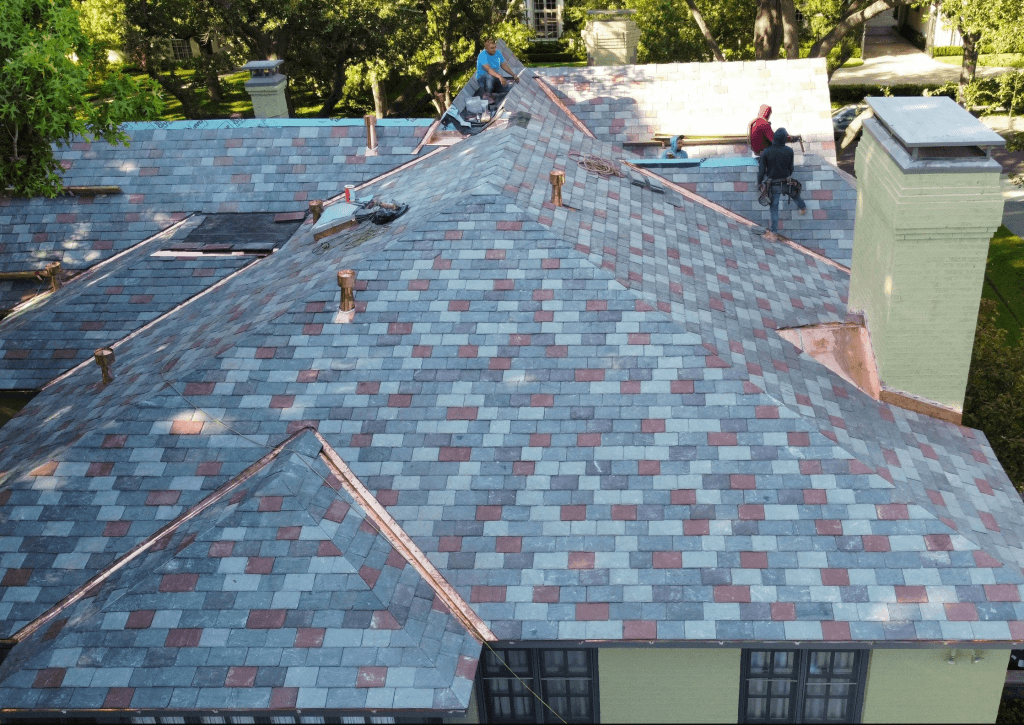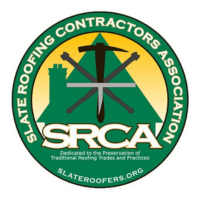Slate Roofing
Slate stands out as an exceptional roofing material due to its unique combination of durability, aesthetics, and environmental sustainability. Composed of natural stone, typically metamorphic rock, slate roofing boasts an impressive lifespan, often exceeding a century with proper maintenance. Its innate resistance to harsh weather conditions, including fire and extreme temperatures, makes it a resilient choice for roofing.
Beyond its durability, slate is renowned for its timeless elegance and aesthetic versatility. Available in a range of colors and thicknesses, slate roofing allows for customized designs that complement various architectural styles. The material’s natural beauty adds a touch of sophistication to any structure, making it a popular choice for high-end residential and historical
restoration projects.
Furthermore, slate’s eco-friendly attributes contribute to its appeal. As a natural material, slate requires minimal processing during extraction and production, resulting in a lower environmental impact compared to synthetic roofing alternatives. Additionally, its longevity reduces the need for frequent replacements, minimizing waste and resource consumption over time.

In summary, slate emerges as the premier roofing material by seamlessly blending longevity, aesthetic appeal, and environmental responsibility, making it a favored choice for those seeking a durable, visually appealing, and sustainable roofing solution.
Frequently Asked Slate Questions
Slate is blind nailed, slate over slate, all the way up the slopes of your roof. This method of installation makes repairs a bit trickier. To make the roof “as good as new” we would need to replace all the slates above it as well. Clearly this is a rather expensive method, and not always
a necessary method.
That is why there are only two true repair methods for a broken slate. The first is called a hook repair. Once the broken slate is removed via a slate ripper, a stainless steel or copper wire is inserted about halfway up where the slate would lie. The hook is inserted into the pre- drilled hole and then the new slate is placed on the hook to hold it in place.
The second method is called a bib repair. Once the old slate is ripped out, you simply slide the new slate in with a nail hammered in between the new and neighboring slate. Then with copper, a bib is made to slide underneath the slate and over the nail that was hammered
in the keyway.
If you have two minutes, the easiest way to understand the repair methods is via this video provided by our partners at the National Slate Association.
We get asked often what all the orange or brown residue is up on customer’s roofs. What the customer is seeing is the rusting out of the slate. Slates have iron pyrites in them which over time oxidize and cause rust. In some senses, this is an inevitable byproduct of the material.
However, at Priority Roofing we only work with the best products and producers. Through our quarries, we are able to obtain 100 year warranties against any forms of rust forming on the slates. The caveat is that colors meant to weather or fade, such as weathering gray or weathering gray will still rust.
What we’ve found is some customers like the look of slates rusting out. It can give the slate an even more aged and natural appearance. Others prefer a much cleaner look without any imperfections. For those who want it to show rust, the weathering colors are a great option,
but those opposed can use only non-fading colors. It is worth noting that “When in an advanced state, the affected area can be flakey and soft due to the increased volume of the oxidation product compared to that of the original pyrite. Replacement of the slate is required to prevent further deterioration and staining.” 1
The presence of oxidizable iron pyrites in slate shingles can cause rust staining on the surface of adjacent slates and appear unsightly. The condition, sometimes called “rusting-out,” occurs most often in New York/Vermont weathering green slate, but sometimes in unfading green as well. The condition is typically isolated to a relatively few slates. When in an advanced state, the affected area can be flakey and soft due to the increased volume of the oxidation product compared to that of the original pyrite. Replacement of the slate is required to prevent further deterioration and staining.
History
If you’ve lived in Texas for any amount of time, you’ve seen your fair share of hail. But while every asphalt roof around you seemingly gets replaced after a storm, you’ve got a 100- year slate roof. Right?
Slate is the only natural roofing product in the world, and it is also the best, cut right from the ground and put directly on the roof. Historians tells us that the first roof may date back to 1st Century Rome’s Fort of Segontium located (it’s ruins at least) in present day Wales. 1
Wales is also the home of the first private house with a slate roof on record around the 1300’s.
In fact, many a slate roof in Europe is over 250 years old. So why would you need yours replaced after only 30 years? Simply stated, slate roofs last much better where there is no hail. However, they’re still beautiful and impressive roofs, but they need much more attention in
Texas than in England.
Hail
A common misconception is that hail damage on slate isn’t bad unless it looks like “bullet holes.” As Vermont Slate Company makes clear, “Many times it’s edge breaks and cracks. The key is to find fresh breaks identified by the lack of aging and dirt on the slate
underneath.” 2
While fractures in slate can seem innocent, once weather events such as wind or freeze comes the roof will shed those fractured slates. This is because the fractures hold moisture and expand, making the slate susceptible to breakage. Even from hail only an inch large.
Determining whether to repair or replace can be a multifaceted decision. The first consideration is the extent of damaged slates. A good general rule is if 20-30% of the slates are damaged, it’s better to replace than repair. 3 Secondly, the homeowners insurance policy must
be considered as well. The company, policy, and deductible will all play a factor in deciding whether to file a claim towards a replacement or repair. 4 A third consideration is the repairability. Because slate is blind nailed one over the other, repairs are neither simple nor permanent. Thus, the insurance often cannot deem a repair as solution if it not truly bringing the roof back to its pre-storm condition. 5
In conclusion, slate roofs are historic and beautiful, but require attention and maintenance in storm riddled states like Texas. This is why we offer free annual inspections for our customers. Hail damage to slate can be tricky and not many contractors or adjusters are familiar with such a high end, niche product. If you’re interested in an assessment of your roofs condition, give us a call for a free drone inspection.
1 https://historypoints.org/index.php?page=segontium-roman-fort-remains-caernarfon
2 https://vermontslateco.com/file-insurance-claim-hail-damaged-slate-roof/
3 https://www.ncslate.com/resources/blog/4-things-know-hail-damage-slate-roof/
4 For more on which insurance companies are best for high end homes, see this article.
5 For the two different slate repair methods, see this article.


